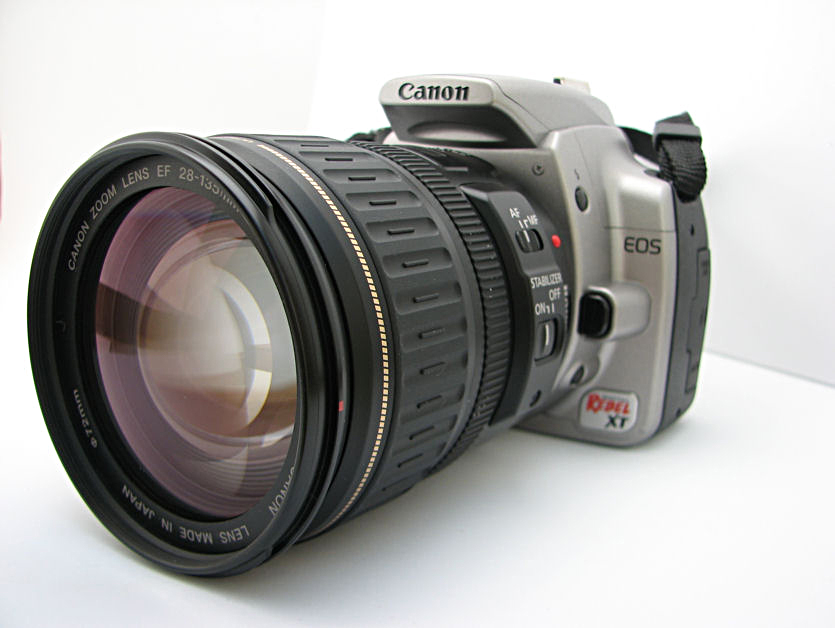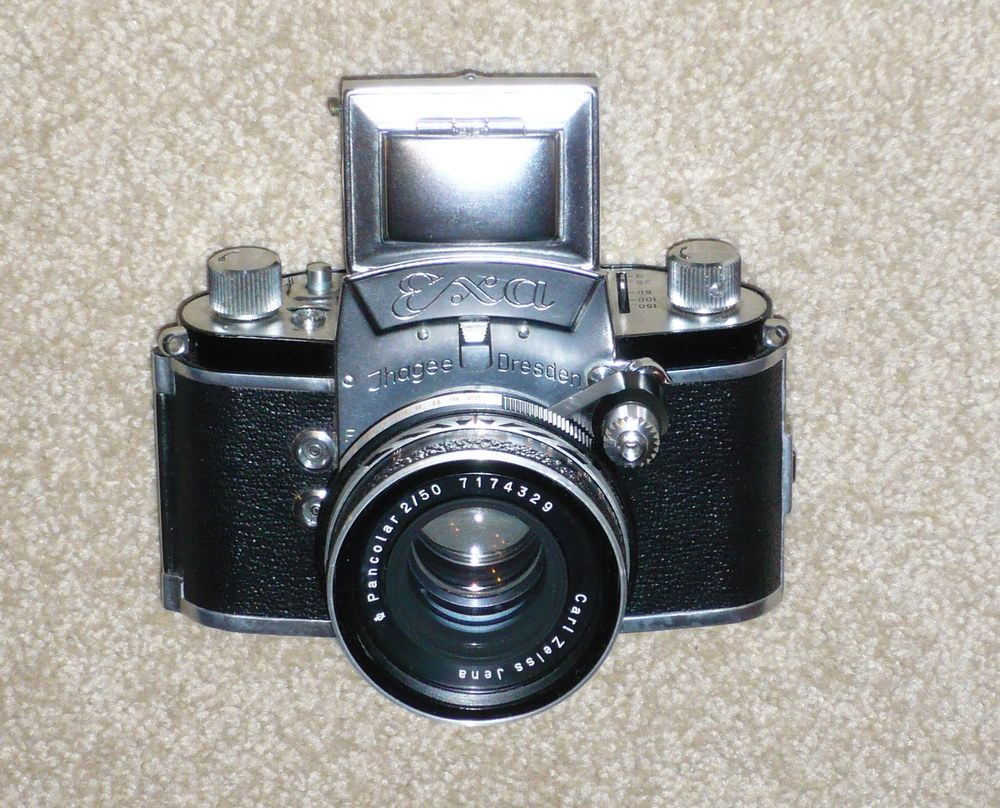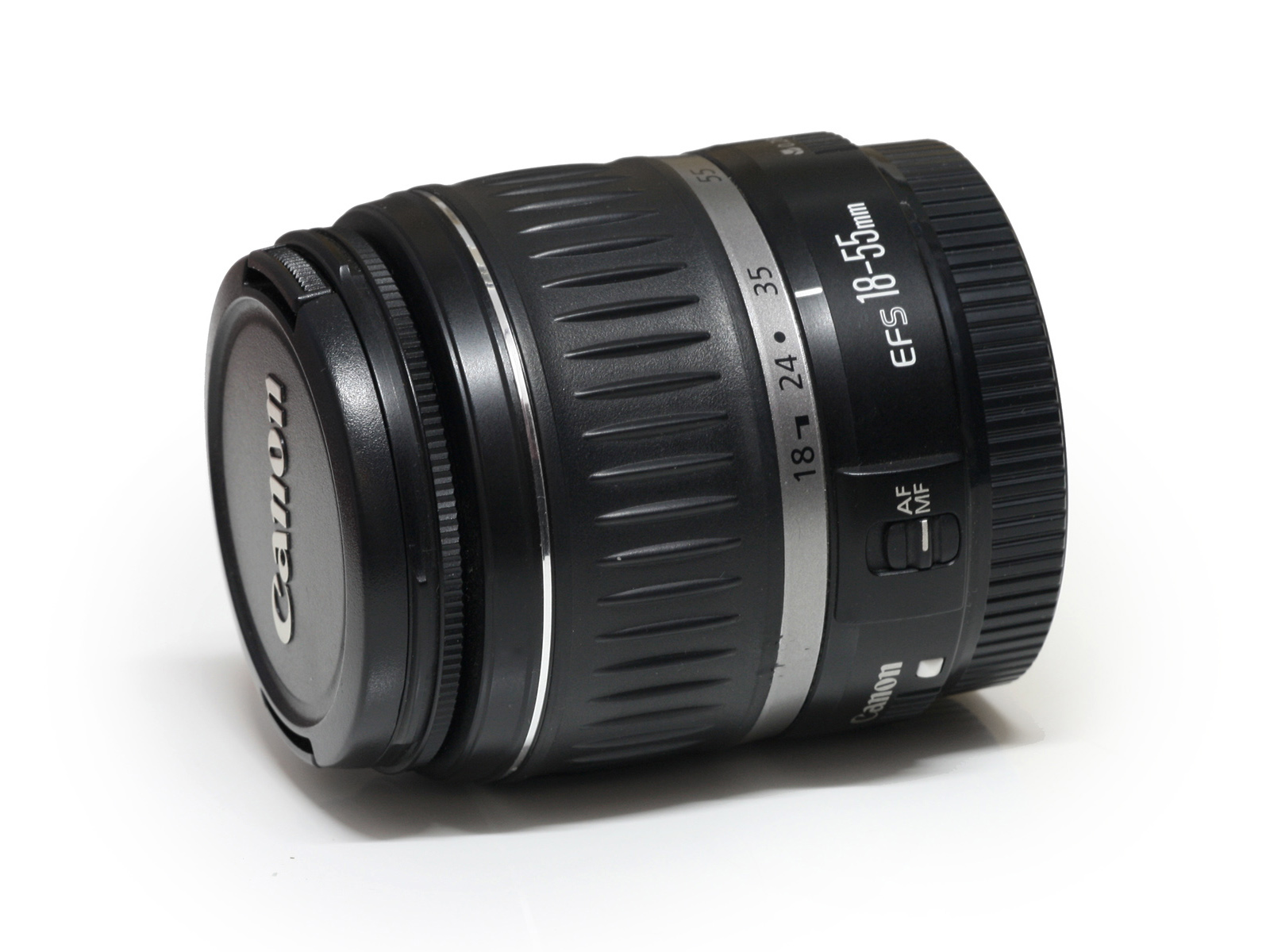|
Canon EOS 350D
The Canon EOS 350D (Canon EOS Digital Rebel XT in North America and the Canon EOS Kiss Digital N in Japan) is an 8.0-megapixel entry-level digital single-lens reflex camera manufactured by Canon. The model was initially announced in February 2005. Part of the EOS range, it is the successor to the EOS 300D and the predecessor to the EOS 400D (or Digital Rebel XTi), which was released in August 2006. Details The 350D is an upgraded version of the Canon EOS 300D, which was the first sub-US$1000 digital SLR, introduced in 2003. There are some differences between the 350D and the 300D. Many of the features 'locked out' by Canon in the 300D were unlocked in this camera, so it has been subject to less unofficial 'hacking' to release the locked features. In addition to these unlocked features, a number of other improvements have been made. Some of the most significant upgrades include: * 8.0 megapixels (up from 6.3) * DIGIC II image processor * Faster power on times (0.2 seconds) * Co ... [...More Info...] [...Related Items...] OR: [Wikipedia] [Google] [Baidu] |
Single-lens Reflex Camera
A single-lens reflex camera (SLR) is a camera that typically uses a mirror and prism system (hence "reflex" from the mirror's reflection) that permits the photographer to view through the lens and see exactly what will be captured. With twin lens reflex and rangefinder cameras, the viewed image could be significantly different from the final image. When the shutter button is pressed on most SLRs, the mirror flips out of the light path, allowing light to pass through to the light receptor and the image to be captured. History File:Hasselblad 1600F.jpg, Medium format SLR by Hasselblad (Model 1600F), Sweden File:Zenza BRONICA S2 with ZENZANON 100mm F2.8.JPG, Medium format SLR by Bronica (Model S2), Japan. Bronica's later model—the Bronica EC—was the first medium format SLR camera to use an electrically operated focal-plane shutter File:Asahiflex600.jpg, The 1952 (Pentax) Asahiflex, Japan's first single-lens reflex camera. File:Contaflex BW 2.JPG, The Contaflex III a single- ... [...More Info...] [...Related Items...] OR: [Wikipedia] [Google] [Baidu] |
Digital Single-lens Reflex Camera
A digital single-lens reflex camera (digital SLR or DSLR) is a digital camera that combines the optics and the mechanisms of a single-lens reflex camera with a digital imaging sensor. The reflex design scheme is the primary difference between a DSLR and other digital cameras. In the reflex design, light travels through the lens and then to a mirror that alternates to send the image to either a prism, which shows the image in the viewfinder, or the image sensor when the shutter release button is pressed. The viewfinder of a DSLR presents an image that will not differ substantially from what is captured by the camera's sensor as it presents it as a direct optical view through the main camera lens, rather than showing an image through a separate secondary lens. DSLRs largely replaced film-based SLRs during the 2000s. Major camera manufacturers began to transition their product lines away from DSLR cameras to mirrorless interchangeable-lens cameras (MILC) beginning in the 2010s ... [...More Info...] [...Related Items...] OR: [Wikipedia] [Google] [Baidu] |
Canon EF-S 18–55mm Lens
The Canon EF-S 18–55mm lens 3.5–5.6 is a Canon-produced wide-angle to mid telephoto zoom lens for digital single-lens reflex cameras with an EF-S lens mount. The field of view has a 35 mm equivalent focal length of 28.8–88mm, and it is a standard kit lens on Canon's consumer APS-C DSLRs. In February 2017 Canon announced the new Canon EF-S 18–55mm lens 4–5.6 IS STM with a smaller aperture, which made the lens 20% smaller according to Canon. There have been nine iterations of this lens, five of which are discontinued and four of which are currently in production: III (kit only and most 'basic'), IS II, and the two IS STM lenses. * I USM (discontinued) * I (discontinued) * II USM (discontinued) * II (discontinued) * IS (discontinued) * IS II (current) * III (current) * IS STM (the most popular) (current) * 4-5.6 IS STM (current) EF-S 18–55mm USM I/II / EF-S 18–55mm I/II The lens body has a plastic construction, including the lens mount. Generally, however, this ... [...More Info...] [...Related Items...] OR: [Wikipedia] [Google] [Baidu] |
Hot Shoe
Canon EOS 350D Hot shoe Proprietary hot shoe used by Minolta and older Sony cameras (Konica Minolta Maxxum 7D">Sony.html" ;"title="Minolta and older Sony">Minolta and older Sony cameras (Konica Minolta Maxxum 7D) A hot shoe is a mounting point on the top of a camera to attach a flash (photography), flash unit and other compatible accessories. It takes the form of an angled metal bracket surrounding a metal contact point which completes an electrical connection between camera and accessory for standard, brand-independent flash synchronization. The hot shoe is a development of the standardised "accessory shoe", with no flash contacts, formerly fitted to cameras to hold accessories such as a rangefinder, or flash connected by a cable. The dimensions of the hot shoe are defined by the International Organization for Standardization in ISO 518:2006. Details such as trigger voltage are not standardised; electrical incompatibilities are still possible between brands. Design The h ... [...More Info...] [...Related Items...] OR: [Wikipedia] [Google] [Baidu] |
Lexar
Lexar Media, Inc. is a Chinese brand of flash memory products manufactured by the Chinese company Longsys. The Lexar "JumpDrive" trademark was often used synonymously with the term USB flash drives when the technology was first adopted. History Early years (1996-2006) Lexar was founded as an American manufacturer of digital media products based in San Jose, California. Products manufactured by Lexar include SD cards, CompactFlash cards, USB flash drives, card readers and solid-state drives. Once a division of Cirrus Logic, Lexar leveraged its parent company's experience in building ATA controllers in developing its own flash controllers. Lexar was spun off from Cirrus Logic in 1996. Lexar was created by Petro Estakhri and Mike Assar. In 2005, Lexar was awarded $380 million in a lawsuit against Toshiba who copied Lexar's flash memory technology. Under Micron ownership (2006-2017) Lexar was acquired by Micron Technology in 2006, and subsequently merged with Crucial ... [...More Info...] [...Related Items...] OR: [Wikipedia] [Google] [Baidu] |
Digital Photo Professional
Digital Photo Professional (DPP) is the software that Canon ships with its digital SLR (and some of its compacts, e.g. the Canon PowerShot S90) cameras for editing and asset management of its Canon raw (.CR2) files. It can also work with the older .CRW format of selected models, and also JPEGs and TIFFs from any source. The full version ships on a CD with the camera, and updates can be downloaded from Canon's website. Even though officially DPP only supports Windows and Mac operating systems, it is possible to run DPP on Linux systems by using Wine. Editing tools Basic editing tools in DPP include brightness, white balance and picture style adjustment and the adjustments for contrast, saturation and sharpness. There is also a noise reduction tool which has separate settings for luminance and chrominance noise. Lens aberration tool can be used for correcting the effects of physical lens imperfections like peripheral illumination, distortion and chromatic aberration. Aberration tool ... [...More Info...] [...Related Items...] OR: [Wikipedia] [Google] [Baidu] |
Lithium Ion Battery
A lithium-ion or Li-ion battery is a type of rechargeable battery which uses the reversible reduction of lithium ions to store energy. It is the predominant battery type used in portable consumer electronics and electric vehicles. It also sees significant use for grid-scale energy storage and military and aerospace applications. Compared to other rechargeable battery technologies, Li-ion batteries have high energy densities, low self-discharge, and no memory effect (although a small memory effect reported in LFP cells has been traced to poorly made cells). Chemistry, performance, cost and safety characteristics vary across types of lithium-ion batteries. Most commercial Li-ion cells use intercalation compounds as the active materials. The anode or negative electrode is usually graphite, although silicon-carbon is also being increasingly used. Cells can be manufactured to prioritize either energy or power density. Handheld electronics mostly use lithium polymer batteries ... [...More Info...] [...Related Items...] OR: [Wikipedia] [Google] [Baidu] |
USB 2
Universal Serial Bus (USB) is an industry standard that establishes specifications for cables, connectors and protocols for connection, communication and power supply ( interfacing) between computers, peripherals and other computers. A broad variety of USB hardware exists, including 14 different connector types, of which USB-C is the most recent and the only one not currently deprecated. First released in 1996, the USB standards are maintained by the USB Implementers Forum (USB-IF). The four generations of USB are: USB 1.''x'', USB 2.0, USB 3.''x'', and USB4. Overview USB was designed to standardize the connection of peripherals to personal computers, both to communicate with and to supply electric power. It has largely replaced interfaces such as serial ports and parallel ports, and has become commonplace on a wide range of devices. Examples of peripherals that are connected via USB include computer keyboards and mice, video cameras, printers, portable media playe ... [...More Info...] [...Related Items...] OR: [Wikipedia] [Google] [Baidu] |
Autofocus
An autofocus (or AF) optical system uses a sensor, a control system and a motor to focus on an automatically or manually selected point or area. An electronic rangefinder has a display instead of the motor; the adjustment of the optical system has to be done manually until indication. Autofocus methods are distinguished as active, passive or hybrid types. Autofocus systems rely on one or more sensors to determine correct focus. Some AF systems rely on a single sensor, while others use an array of sensors. Most modern SLR cameras use through-the-lens optical sensors, with a separate sensor array providing light metering, although the latter can be programmed to prioritize its metering to the same area as one or more of the AF sensors. Through-the-lens optical autofocusing is usually speedier and more precise than manual focus with an ordinary viewfinder, although more precise manual focus can be achieved with special accessories such as focusing magnifiers. Autofocus accuracy ... [...More Info...] [...Related Items...] OR: [Wikipedia] [Google] [Baidu] |
Mirror Lock-up
Mirror lock-up (often abbreviated to MLU) is a feature employed in many Single Lens Reflex (SLR) cameras. It allows the operator to reduce vibration-induced motion blur during exposure. It also allows the mounting of lenses which extend into the SLR's mirror box when mounted. Reducing vibration Normal operation in an SLR camera involves flipping the mirror up out of the light-path just before the shutter opens, and then returning it when the shutter closes (although very early SLR's required the shutter to be cocked for the mirror to return). This causes vibration of the camera, particularly when the mirror slaps into the top of the mirror box. This vibration quickly dies away so the most motion blur is actually seen with short shutter times that capture multiple 'swings' of the vibration (shutter speeds of 1/2 to 1/60 second are often affected by this). While longer exposures will capture all of the vibrations, the exposure will be dominated by light captured when the camera ... [...More Info...] [...Related Items...] OR: [Wikipedia] [Google] [Baidu] |
Canon EOS Flash System
Canon's EOS flash system refers to the photographic flash mechanism used on Canon's film (35mm and APS) or digital EOS single-lens reflex cameras. The line was first introduced in 1987. It has gone through a number of revisions over the years, as new flash exposure metering systems have been introduced. The main light-metering technologies are known as A-TTL, E-TTL, and E-TTL II. The EOS flash system is capable of wireless multiple flash control, whereby a master flash unit IR ( ST-E2) or RF ( ST-E3-RT) transmitter mounted on the camera body can control up to 3 (optical) or 5 (radio) groups of flash units. The Canon EOS 7D is the first Canon body to be able to control Speedlites wirelessly without the use of a Master Speedlite or IR transmitter; four other EOS models, the 60D, 600D, 650D, 70D, and 700D, also have wireless flash capabilities. The 7D is capable of handling three slave groups. The other cameras can handle two slave groups. Metering systems Canon has in ... [...More Info...] [...Related Items...] OR: [Wikipedia] [Google] [Baidu] |




.jpg)
